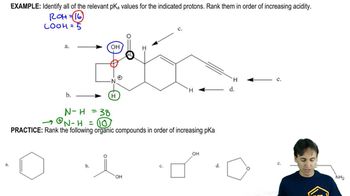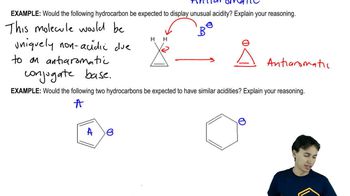Here are the essential concepts you must grasp in order to answer the question correctly.
Acidity and pKa
Acidity in organic chemistry is often measured by the acid dissociation constant (Ka), which quantifies the strength of an acid in solution. A higher Ka value indicates a stronger acid, meaning it dissociates more completely in water. The pKa, which is the negative logarithm of Ka, is commonly used to compare acid strengths; lower pKa values correspond to stronger acids.
Recommended video:
Resonance Stabilization
Resonance stabilization occurs when a molecule can be represented by multiple valid Lewis structures, allowing for the delocalization of electrons. In the case of phenol, the negative charge on the phenoxide ion (the conjugate base) can be delocalized over the aromatic ring, enhancing its stability compared to cyclohexanol, which lacks such resonance stabilization.
Recommended video:
The radical stability trend.
Comparative Acid Strength
To determine which compound is a stronger acid, one must compare their ability to donate protons (H+). Phenol is generally a stronger acid than cyclohexanol due to the resonance stabilization of its conjugate base, phenoxide. This stabilization lowers the energy of the conjugate base, making it more favorable for phenol to lose a proton compared to cyclohexanol.
Recommended video:
Comparing hydrocarbon acidity


 Verified step by step guidance
Verified step by step guidance Verified video answer for a similar problem:
Verified video answer for a similar problem:



 3:15m
3:15m